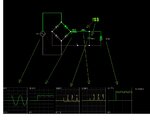Unknown1980
Newbie level 6
Hi all
I'm new to these forums.
I am planning to build a multistage LC low pass filter for the output of an AC to DC converter.
The output of the supply will be adjustable between 6V - 12V at 2A of steady current. The required cut off frequency required for the multi-stage filter is 2Hz.
The problem I am having is, that despite the calculations required to design such a filter, actual capacitors and inductors are not ideal, therefore the inductance and capacitance values that I actually need to use, may be very different than the values specified by the mathematical equations.
For example, It is almost a certainty that I will need to use electrolytic capacitors, which means that there will be no high frequency attenuation above a few hundred Kilohertz when the capacitors become inductive.
This won't matter, as I have other methods of dealing with the higher frequencies, but my main goal right now, is to achieve a filtered band from 2Hz up to 200KHz.
If anyone has an suggestions, they would be much appreciated.
I'm new to these forums.
I am planning to build a multistage LC low pass filter for the output of an AC to DC converter.
The output of the supply will be adjustable between 6V - 12V at 2A of steady current. The required cut off frequency required for the multi-stage filter is 2Hz.
The problem I am having is, that despite the calculations required to design such a filter, actual capacitors and inductors are not ideal, therefore the inductance and capacitance values that I actually need to use, may be very different than the values specified by the mathematical equations.
For example, It is almost a certainty that I will need to use electrolytic capacitors, which means that there will be no high frequency attenuation above a few hundred Kilohertz when the capacitors become inductive.
This won't matter, as I have other methods of dealing with the higher frequencies, but my main goal right now, is to achieve a filtered band from 2Hz up to 200KHz.
If anyone has an suggestions, they would be much appreciated.
